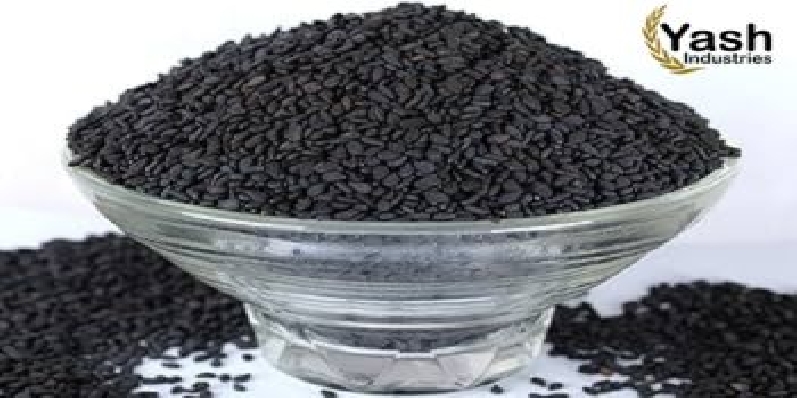
13-05-2024
From Seed to Superfood: The Journey of Black Sesame Seeds
- Admin
Introduction
Black sesame seeds, known as "kala til" in Hindi, are a staple in Asian cuisine and traditional medicine. They are small, flat seeds with a nutty flavor and a crunchy texture. These seeds are rich in protein, fiber, vitamins, minerals, and antioxidants, making them a valuable addition to any diet.
The journey of black sesame seeds from seed to superfood is intriguingly set apart by centuries of cultivation and a rich cultural history. These seeds have been used for thousands of years in Asian cultures for their medicinal properties and as a symbol of prosperity and good luck. Today, they are gaining popularity in Western cuisine for their unique flavor and versatility.
5 Health Benefits of Black Sesame Seeds
Black sesame seeds are filled with fundamental nutrients, making them an important addition to any diet. Here are the top 5 health benefits of black sesame seeds:
-
Rich in Nutrients: Black sesame seeds are a good source of protein, fiber, vitamins, and minerals. They are particularly high in calcium, iron, magnesium, and phosphorus, which are required for bone health, energy production, and overall vitality.
-
Antioxidant Properties: Black sesame seeds are rich in antioxidants, including sesamin and sesamolin, which help protect the body from oxidative stress and reduce the risk of chronic diseases such as heart disease, cancer, and diabetes.
-
Heart Health: Consuming these seeds regularly may help improve heart health by lowering cholesterol levels and blood pressure. The high fiber content in these seeds also supports digestive health, which is important for cardiovascular function.
-
Anti-inflammatory Effects: These seeds have anti-inflammatory properties, which can help reduce inflammation and alleviate symptoms of inflammatory conditions such as arthritis and asthma in the body.
-
Skin and Hair Health: The nutrients include maintaining skin elasticity, promoting collagen production, and preventing premature aging.
Culinary Uses of Black Sesame Seeds
Black sesame seeds are a popular ingredient in Asian cuisine, These seeds are used in sweet and savory dishes. In traditional Chinese and Japanese cooking, These seeds are often ground into a paste and used as a filling for pastries and dumplings. They are also sprinkled on rice dishes, noodles, and vegetables for flavor and crunch.
In modern cuisine, these seeds are used in different ways to add depth and complexity to dishes. They can be toasted and sprinkled on salads or used as a topping for breads and desserts. Black sesame seed oil is also used for cooking and as a flavoring agent in sauces and dressings.
One of the most popular uses of these seeds is in baking. They are often added to bread, cakes, and cookies to impart a rich, nutty flavor and a distinctive black-speckled appearance. These seeds can also be ground into flour and used as a gluten-free alternative in baking.
Recipes of Black Sesame Seeds
-
Black Sesame Seed Cookies: A delicious treat packed with nutrients and flavor.
-
Black Sesame Seed Salad Dressing: A unique twist to your favorite salad.
-
Black Sesame Seed Smoothie: A nutritious and refreshing drink.
The Cultivation Process of Black Sesame Seeds
The cultivation process of black sesame seeds plays a crucial role in their journey from seed to superfood. This subtopic explores how these seeds are grown, harvested, and processed to ensure their quality and nutritional value.
Growth Conditions
Black sesame seeds thrive in tropical and subtropical regions, which need soil and sunlight. They are planted in rows with spacing for proper growth and development. Adequate water and occasional fertilization are required to support the growth of healthy plants.
Planting and Germination
These seeds are usually planted directly into the soil by hand or using mechanical planters. The seeds are sown at a shallow depth and covered lightly with soil. Germination occurs within a few days, and the seeds sprout into small seedlings.
Growth and Development
As the seedlings grow, they develop into mature plants with tall stems and narrow leaves. Black sesame plants can reach about 3 to 5 feet, depending on the variety and growing conditions. The plants require regular watering and occasional pruning to ensure healthy growth.
Flowering and Pollination
Black sesame plants produce small bell-shaped flowers that are pale pink or white. These flowers are attractive to pollinators like bees and butterflies, which help in the pollination process. Once pollinated, the flowers develop into seed pods containing the black sesame seeds.
Harvesting
The harvest of black sesame seeds typically occurs around 90 to 120 days after planting, depending on the growing conditions. The seeds are ready for harvest when the seed pods turn brown and start to crack open. Harvesting is done manually or using mechanized equipment, and the seeds are collected and dried before further processing.
Conclusion
Black sesame seeds are not just a flavorful addition to your meals but also a powerhouse of nutrients and health benefits. From their rich history to modern applications, these tiny seeds have come a long way to earn their status as a superfood. Incorporating black sesame seed products into your diet can be a simple yet effective way to boost your overall health and well-being.
The cultivation process of black sesame seeds is meticulous, requiring specific growing conditions and careful attention to ensure the quality of the final product. From planting and germination to flowering and harvesting, each step in the process contributes to these seeds' unique flavor and nutritional profile.